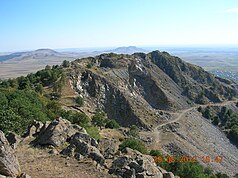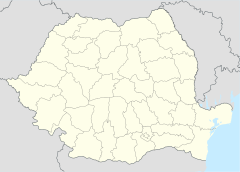Măcin Mountains National Park
| Măcin Mountains National Park | ||
|---|---|---|
| Munții Măcinului National Park | ||
|
|
||
| Location: | Tulcea , Romania | |
| Surface: | 2.1 km² | |
| Founding: | 2000 | |
| Munții Măcinului National Park | ||
The Măcin Mountains National Park (Romanian: Parcul Național Munții Măcinului ) is located in the Măcin Mountains , in the north of the Tulcea County , Romania . It extends over an area of 21 hectares.
description
In 1998 parts of the Măcin Mountains were placed under nature protection for the first time, and in 2000 the national park was established by law (Legea nr. 5/2000) on an area of 11,321 hectares.
The Măcin Mountains, with a height of 400 meters, are the oldest mountains in Europe. The nature reserve offers 11 marked and signposted trails, including several themed trails, a cycle path and a horse trail. The Pontic-Sarmatian steppe is the only protected steppe region in Europe.
flora
562 plant species have been counted in the Măcin Mountains National Park. Some of them are here at the northernmost limit of their habitat. There are six plant species that are on the European list of strictly protected plant species, including Campanula romanica , Dianthus nardiformis and Galanthus plicatus .
Of the rare flowers that only grow here, most are succulent or extremely frugal in their water requirements. The oak forests with wild peonies are a specialty .
fauna
The Măcin Mountains are home to rare animals such as the Moorish tortoise ( Testudo graeca ibera ), the climbing snake ( Elaphe quatuorlineata ) and the European horned viper ( Vipera ammodytes ), the most poisonous snake in the Romanian fauna.
There live here near the Danube Delta , numerous bird species, including the European roller ( Coracias garrulus ), the bee-eater ( Merops apiaster ), the saker falcon ( Falco cherrug ) and the Nonnensteinschmätzer ( Oenanthe pleschanka ).
Over 900 species of butterflies live in the Măcin Mountains National Park . 13 species of large birds live here all year round. For many birds, only the park offers nesting zones and thus serves as a genetic reservoir for other regions.
Nature reserves
The most important geological and botanical nature reserves of the national park are the fossil deposit Peony Hill Dealul Bujoarele , the beech forest Valea Fagilor and the boulder Popina Blasova .
For geologists, the park with its fossil sites and strange rock formations is an Eldorado. The rock formations "ears", "dinosaur eggs" or the "Dobrudscha-Sfinx" should be mentioned. Two zones are subject to the strictest protection: the Moroian and Valea Fagilor scientific reserves, where a species of beech grows that is otherwise only found in the Crimea. The rare downy oak ( Quercus pubescens ) can also be found here.
See also
Web links
- parcmacin.ro , Munții Măcinului National Park
- youtube.com , Munții Măcinului National Park
- peterlengyel.wordpress.com , Munții Măcinului National Park
- prefecturatulcea.ro , Munții Măcinului National Park
- L. Rákosy, C. Wieser: The Macin Mountains (Romania, North Dobruja). In: Carinthia II. Klagenfurt 2000, PDF on ZOBODAT
Individual evidence
- ↑ parcmacin.ro , history
- ↑ a b c d adz.ro , At the foot of the Măcin National Park
- ↑ a b c d rumaenien-tourismus.de ( memento from March 6, 2014 in the Internet Archive ), nature tourism


